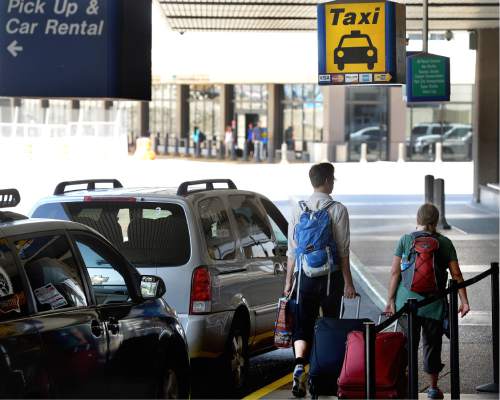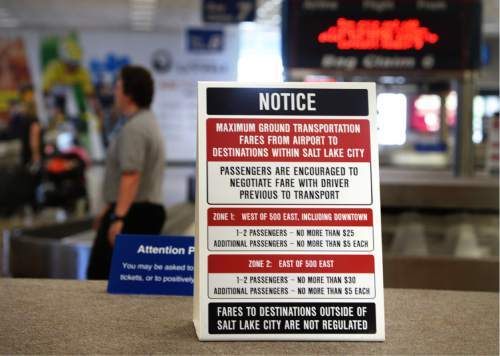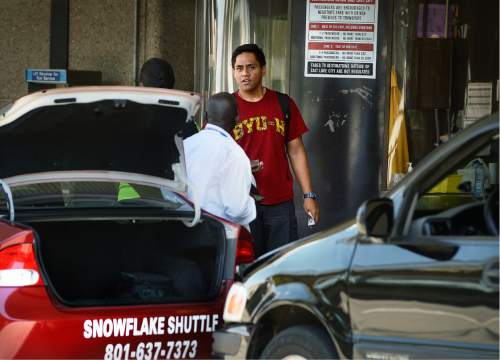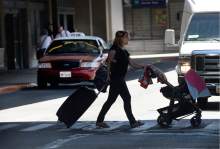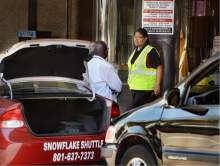This is an archived article that was published on sltrib.com in 2016, and information in the article may be outdated. It is provided only for personal research purposes and may not be reprinted.
A few weeks and one trip too late, Emmaline Newman noticed signs in the baggage claim at Salt Lake City International Airport warning about new, mostly unregulated taxi rates — urging travelers to negotiate fares before taking a cab.
"Thank you for the sign," she wrote to airport officials. She only wished she had seen it before returning from her recent honeymoon, when "I had a driver try to charge me $200 for a one-way fare to my home in Cottonwood Heights."
Newman is not alone.
Piles of complaints tell stories of gouging: a $25 ride to an airport hotel less than two miles from the terminal, $132 to go to Park City (which cost $85 previously) or $160 to Snowbird (double earlier rates).
Deregulation, largely as a result of the arrival of ride-hailing services Uber and Lyft, has created a Wild West for Salt Lake City area taxis. Emergency action by the airport limited fares within the city to $25 in areas west of 500 East and $30 elsewhere, although complaints say some drivers try to ignore those maximums.
No limits exist for fares outside of the city, notes Larry Bowers, airport operations manager for ground transportation.
He adds that cabs no longer are required to use meters. Some do, but he says the city no longer inspects meters for accuracy, and cabs can set them at any rate they choose.
While Salt Lake City once had three taxi companies — Ute, Yellow and City — Bowers says it now has 436 registered companies, and 276 of them have one or two cabs each. Some complaints call many of them "fly by night" operators that won't accept credit cards and don't offer receipts.
All of them may use airport taxi stands and airport taxi starters — the city-paid workers who assign riders to cabs at airport stands — giving them an air of approval.
Many travelers say they have not seen anything quite like the situation here — no meters, drivers charging whatever they choose and not announcing fares until arrival — at least not in North America.
"The only other cities where I have experienced similar confusion were outside of the United States in Third World countries," Steve Kimmel wrote to the airport.
Charles Rinke wrote, "This is so foreign compared to every other airport I've been to that surely dozens, if not hundreds, of people are getting gouged daily."
"It is a tourism turnoff," Denise Chancellor complained to officials. "If it continues, I will post a note on TripAdvisor that travelers should expect Third World conditions when they try to leave Salt Lake airport."
Airport spokeswoman Nancy Volmer concedes a lot of people are unaware "the traditional metered cab is no longer an option" at the airport and officials hope to better spread the word.
—
Complaints • The Salt Lake Tribune filed an open-records request for complaints since rates were deregulated in early 2015, and the documents obtained yielded some telling stories. For example:
• Magali Thomas took a taxi to Snowbird. "Once we were 15 minutes away from the airport (at 1 a.m. and with two children), [the driver] said that the cost to go to Snowbird was $160, almost double the regular rate. We asked him to take us back to the taxi stand at the airport."
• Rick Brock said he was charged $35 for a ride that in the past cost $19. "I called the company [Clean Transport] to complain about the driver overcharging me and was told West Valley [City, where he was dropped off] is unregulated and he could charge whatever he wanted."
• James Black took a cab to the National Guard base on the far side of the airport. "In the past I have paid $12.50 to $13 for this trip. This time the driver told me it was a flat rate of $25, which we had to pay." The city has a $25 maximum-possible fare in that zone — not a flat rate.
• John Suplick wrote that he "took a cab from the airport to the Hilton Garden at the airport. I cannot believe they can charge $25 to go a couple miles."
• K. Young took a cab to Park City, saying it usually costs about $85. He enclosed a receipt for $132 from a Fidel Transportation cab and asked, "Why is the price so high?"
• Terry Davis asked to take a taxi to Lehi. The "driver did not know how to go south on I-15 to Lehi. Then [he] asked me to use my phone to look it up. Then [he] argued with me that I should give him my phone to guide the route." Davis added he could not get a badge number from the driver. "Charge was $75."
• Ericka Eve said halfway to the Marriott University Park hotel, her cabdriver said he needed gasoline. He said he forgot his wallet and asked her for cash to fill up. She gave him $20. When they arrived, "he said my cab fare was only $20 because he subtracted the other $20 out of the total fare." The fare should have been no more than $30.
"I went to pay him with a credit card and he had the audacity to ask if I had more cash!" Eve wrote.
—
Deregulation • Senior City Attorney Marco Kunz says Salt Lake City's path to deregulation started years ago with dissatisfaction over traditional taxi service and culminated in the past two years with changes to accommodate Uber and Lyft.
Bowers, the airport ground transportation manager, said the city was tired of years of constant complaints that taxi service "was terrible."
It sought in 2010 to do away with "certificates of convenience and necessity" it had provided to Ute, Yellow and City taxi companies — which had allowed the city to set rates, and gave them exclusive rights for on-demand service at the airport.
The city attempted to switch to a contract for taxi service and chose two out-of-state firms. Yellow and Ute challenged the move in court and won a temporary restraining order — so the status quo remained for three years.
Meanwhile, Uber and Lyft appeared. At first, they operated illegally at the airport "and we cited them," Bowers said. But the City Council in 2014 passed an ordinance allowing them to operate anywhere in the city, except the airport.
That ordinance also eliminated requirements that nontaxis, including shuttles and limousines, must charge fares of at least $30 and arrange rides 30 minutes in advance. The out-of-town cab companies that had won the city contract asked to be released from it because they no longer would have exclusive rights for airport on-demand service.
With no contract or certificates of convenience and necessity, Kunz said, the city could not regulate fares. In early 2015, taxis started charging what they wanted.
Meanwhile, the Legislature passed a law that gave Uber and Lyft rights to operate at the airport, but it let the airport charge fees and determine which curbs the services could use. Last September, they started operating legally at the airport. They now have 30 percent of the on-ground transportation market there.
—
No contract • Kunz said, with Uber and Lyft operating, the city cannot find a cab company that wants the formal city contract — which could retrigger regulated rates and exclusivity to airport taxi stands.
She said a contract would require a company to serve the entire city at all hours all days, "and not just pick and choose the nice" fares. Potential bidders "said to us, if the city wants that service, the city's got to subsidize that. There's not been much appetite for that," she said.
Meanwhile, Bowers said it is easy now to operate as a taxi service and have access to the airport taxi stands and nearly unlimited fares. Firms need a city business license, must have their cabs inspected, have insurance verified and have drivers undergo a criminal-background check. Cabs then receive a tag and may operate.
When some cabbies started seeking high rates, Kunz said, downtown hotels complained that visitors were being gouged.
Kunz said Maureen Riley, the city's executive director of airports, then took advantage of a law that allows her to act unilaterally to address emergency conditions. She issued a notice that lack of regulated rates created an "emergency" and imposed maximums of $25 for taxi rides east of 500 East, and $30 within the city beyond that.
The City Council, which has power to override the order, let it stand for the past year and a half, and it may continue for the foreseeable future, Kunz said.
The cap only helps travelers within Salt Lake City. No restrictions are placed on fares elsewhere. "We have no jurisdictional right" for that, Bowers said. He adds that it's always been that way, but metered cabs previously tended to charge what meters showed, so it wasn't an issue.
—
Taxi stands • The current situation leads to complaints beyond price gouging. Several involve airport taxi stands, which give access to cabs from staging areas on a first-come, first-served basis — and have airport-contracted employees assigning passengers to them.
Some complain that "taxi starters" pressure passengers to use the next taxi in line even if they request a metered cab or one from a specific company (which they may do legally). Others say when cabbies reject proposed fares, they are rude and refuse to move and make way for others.
Bowers said the airport recognizes such problems and is working on a program to better train the taxi starters provided by the airport's parking contractor.
"The starter needs to be our ambassador," Bowers said.
A related complaint is that starters often put visitors into cabs without warning them about the need to negotiate fares — although the airport has signs at taxi stands and on baggage carousels urging such bargaining.
As Charles Rinke asked in a complaint letter, "Are drivers required to negotiate fares upfront? Or can they just not say anything, hope they get an oblivious passenger and charge whatever they want?"
"They are not required to," Bowers said. "But it's something we could address with our starters and say, 'When you put someone in a car, you should ask where they are going and just advise the person to make sure you understand your fare and rates before you go.' "
—
Not so bad? • Airport officials say the several dozen complaints about deregulation still are relatively few, considering that 22 million people use the airport each year (although that includes passengers on connecting flights).
They add that complaints have decreased since Lyft and Uber have been allowed and are fewer than what they had received about taxis in previous years.
Volmer said a survey by Airport Service Quality — which rates a variety of services at most major international airports — actually ranked Salt Lake City No. 1 among 43 participating airports in North America in 2014 for grand transportation to and from the airport, but that was before deregulation took full effect.
Bowers said the city also uses "secret shoppers" to track service and prices — and to find violations.
Data from those efforts show that Uber and Lyft seem to be lowering fares charged by all ground transportation, including taxis.
In the six months ending in May, he said, an average airport-to-city trip on Uber cost $13.33; Lyft, $26.75; taxis, $27.51; and limousines and other shuttles, $27.31.
"Lyft and Uber are holding rates down," he said. "That was one of our hopes … that the industry will start to compete with these people, and will start to drop their rates a little bit and not charge the max."


